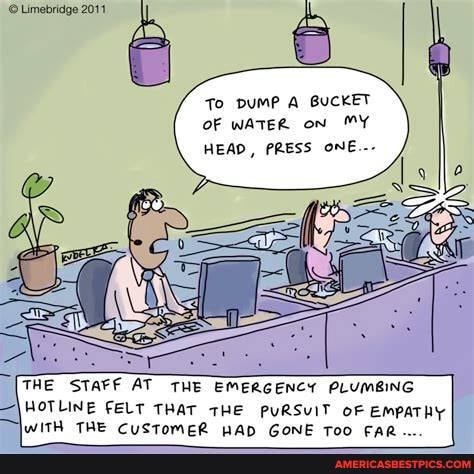Optimizing the efficiency of operations in a plumbing company is crucial for business success. Streamlining processes not only improves service delivery but also boosts profitability and customer satisfaction. Here are ten smart ways to enhance the operational efficiency of your plumbing business. Utilize Modern Technology The integration of modern technology in plumbing operations extends beyond Read more
dispatch

Optimizing the efficiency of operations in a plumbing company is crucial for business success. Streamlining processes not only improves service delivery but also boosts profitability and customer satisfaction. Here are ten smart ways to enhance the operational efficiency of your plumbing business.

Utilize Modern Technology
The integration of modern technology in plumbing operations extends beyond basic administrative tasks. Today’s advanced plumbing tools, such as video inspection cameras and leak detection equipment, can significantly enhance diagnostic accuracy and job efficiency. In addition, software solutions can manage everything from customer appointments to real-time inventory tracking and employee dispatch. Cloud-based platforms offer the flexibility to access this data from anywhere, providing a critical advantage in responsiveness and decision-making. Embracing these technologies not only streamlines operations but also elevates the level of service offered to customers. By staying abreast of technological advancements, a plumbing business can differentiate itself in a competitive market and offer solutions that are both innovative and customer-centric.
Implement Efficient Scheduling and Dispatch Systems
Efficient scheduling and dispatch systems are more than just organizational tools; they are vital for optimizing the allocation of resources and ensuring customer satisfaction. Modern scheduling software often comes with features like GPS tracking, which helps in real-time monitoring of field personnel. This enables more dynamic scheduling, allowing dispatchers to respond to urgent calls more effectively or adjust schedules to accommodate unexpected delays. By reducing the time technicians spend on the road and ensuring prompt service, these systems can significantly enhance both operational efficiency and customer trust. The result is a more agile, responsive service that can adapt to the day’s demands in real-time.

Standardize Procedures and Best Practices
Standardizing procedures goes hand in hand with ensuring quality control in every aspect of the plumbing service. From the initial assessment of a job to the final quality check, standardized procedures ensure consistency and reliability in service delivery. This could include checklists for job completion or standardized customer follow-up protocols. By having a uniform approach, it becomes easier to train new employees and maintain high standards across the board. Furthermore, a standardized set of best practices helps in establishing a strong brand reputation, as customers begin to recognize and appreciate the consistent quality of service.
Invest in Training and Development
Regular training and development programs are pivotal for keeping the workforce up-to-date with the latest industry standards and technologies. These programs can cover a wide range of topics, from advanced plumbing techniques and new equipment training to soft skills like customer service and communication. Investing in your employees’ growth not only enhances their skills but also boosts morale and loyalty. A workforce that feels valued and equipped with the latest knowledge is more motivated and effective, directly contributing to the overall productivity and success of the business.
Optimize Inventory Management
Optimizing inventory management involves more than just keeping track of stock levels. It includes understanding the patterns of supply and demand, seasonal variations in the usage of certain parts, and even staying informed about new and more efficient materials or tools entering the market. An effective inventory system helps in minimizing capital tied up in stock while ensuring that essential items are always available. This balance is crucial for maintaining uninterrupted operations and the ability to respond quickly to customer needs. By streamlining inventory management, a plumbing business can reduce operational costs and improve its capacity to deliver prompt, reliable service.
Foster a Culture of Communication
Developing a culture of communication involves establishing clear channels for feedback and information sharing at all levels of the organization. It’s about creating an environment where employees feel comfortable sharing their insights and where customer feedback is actively sought and valued. This open dialogue can lead to significant improvements in processes, employee engagement, and customer satisfaction. Regular team meetings, open-door policies, and customer surveys can be effective tools in building this culture. In essence, fostering a culture of communication creates a more cohesive, informed, and responsive team.
Utilize Photo Badges for Employees
The use of photo ID badges for employees in a plumbing business serves multiple purposes. Beyond the basic function of identification and security, these badges can be integrated into various operational systems. For instance, they can be linked with job scheduling systems to track time spent on each job, enhancing accountability and aiding in payroll processing. They also project a professional image to customers, enhancing trust and credibility. In the age where security is paramount, showing a clear company ID can reassure customers, particularly when service calls require entering homes or private premises.
Prioritize Preventive Maintenance
Preventive maintenance extends beyond the tools and vehicles used in plumbing jobs; it also encompasses the digital assets of the business. Regular software updates, data backups, and security checks are essential to safeguard the business from technological failures or cyber threats. A comprehensive preventive maintenance plan ensures that all aspects of the business, from physical tools to digital infrastructure, are functioning optimally. This proactive approach can save substantial costs and downtime in the long run and ensures the business is always ready to serve its customers efficiently.
Encourage Feedback and Continual Improvement
Creating a system for continual feedback and improvement is about building a dynamic business model that adapts and grows. This system should encourage not just feedback but also creative problem-solving and innovation. Whether it’s a new approach to customer service, a suggestion for a more efficient workflow, or ideas for new services, employee and customer input can be invaluable. This culture of continual improvement keeps the business at the forefront of the industry, constantly evolving and improving in line with customer needs and market changes.
Monitor and Analyze Performance
Performance monitoring and analysis should encompass various aspects of the business – operational efficiency, customer satisfaction, financial performance, and employee engagement. Utilizing a comprehensive set of KPIs helps in getting a holistic view of the business’s performance. Regular analysis of these metrics allows for informed decision-making and strategic planning. It can identify areas where the business excels and areas that require improvement. By closely monitoring and analyzing performance, a plumbing business can make targeted changes that lead to substantial improvements in efficiency and service quality.
Conclusion
Streamlining the operations of your plumbing company requires a strategic approach, incorporating modern technology, efficient processes, and a focus on continuous improvement. By implementing these ten smart strategies, you can enhance the efficiency and productivity of your business. This not only leads to increased profitability but also strengthens your reputation in the market. In the competitive world of plumbing services, optimizing your operations is key to standing out and achieving long-term success.

Keep your technical knowledge close in the tool bag; emotional intelligence is a highly valued personal trait that can help you run a more successful business. We’ve all heard the expression before, “You’re thinking with you heart and not your head.” But what if both were true? On a recent Thursday night Plumbing Perspective (@plumbing_perspective) Instagram Read more
Keep your technical knowledge close in the tool bag; emotional intelligence is a highly valued personal trait that can help you run a more successful business.
 We’ve all heard the expression before, “You’re thinking with you heart and not your head.” But what if both were true? On a recent Thursday night Plumbing Perspective (@plumbing_perspective) Instagram Live, guest Shreya Nagwani (@_shreymvp), sales/service expert and coach for Service MVP, discussed an interesting aspect of Service MVP’s training that translates to running a successful business. It’s called Emotional Intelligence or EQ. Almost counterintuitive—because of the opposite nature of how people can think one way and act another—the term actually makes an abundant amount of sense.
We’ve all heard the expression before, “You’re thinking with you heart and not your head.” But what if both were true? On a recent Thursday night Plumbing Perspective (@plumbing_perspective) Instagram Live, guest Shreya Nagwani (@_shreymvp), sales/service expert and coach for Service MVP, discussed an interesting aspect of Service MVP’s training that translates to running a successful business. It’s called Emotional Intelligence or EQ. Almost counterintuitive—because of the opposite nature of how people can think one way and act another—the term actually makes an abundant amount of sense.
According to Harvard Business School, Emotional intelligence is defined as the ability to understand and manage your own emotions, as well as recognize and influence the emotions of those around you. The term was first coined in 1990 by researchers John Mayer and Peter Salovey, but was later popularized by psychologist Daniel Goleman. (Goleman lists five components of EQ below.)
In the realm of home service sales, emotional intelligence (EQ) often takes a backseat to technical expertise. However, it is a critical component that should not be overlooked. EQ refers to the ability to understand and manage emotions effectively, enabling individuals to relieve stress, communicate well, empathize, overcome challenges, and defuse conflicts. In the sales process, where emotions heavily influence buying decisions, focusing on logical reasoning alone can leave clients hesitant.
But how does it translate into plumbing and HVAC business? While plumbing and HVAC techs have a high IQ, and what they communicate is overly technical, a non-technician, i.e., customer, doesn’t understand what that means, says Nagwani. “All they want is safety, comfort and health for their family and their home.”
 Home service technicians, typically analytical and left-brained, tend to prioritize the logical aspects of their work, inadvertently neglecting the emotional side of the sales process. The gap lies in the lack of training on communicating solutions in an emotionally intelligent manner. To successfully bridge this gap, technicians must be equipped with the skills to connect with customers on a deeper level, understand their unique needs, and present solutions that resonate emotionally.
Home service technicians, typically analytical and left-brained, tend to prioritize the logical aspects of their work, inadvertently neglecting the emotional side of the sales process. The gap lies in the lack of training on communicating solutions in an emotionally intelligent manner. To successfully bridge this gap, technicians must be equipped with the skills to connect with customers on a deeper level, understand their unique needs, and present solutions that resonate emotionally.
“It’s a very emotional job,” says Nagwani, but there is a gap. “To bridge the gap would be learning emotional intelligence. How do I communicate this job, which is just a plumbing job, to something like, ‘What is the effect of this system for their family? If they have chlorine in their water and their son has eczema.’ That’s how you connect emotional intelligence to a plumbing job,” says Nagwani.
And, not only that, people buy things when they have high self-esteem, when they feel like they deserve it. “People who have a high self-esteem buy premium,” says Nagwani.
How do to techs learn how to communicate that? “What we teach—in part—in our Service MVP offerings is, how do you raise someone’s self-esteem during a visit that by the end of the appointment the client feels better about themselves as a person? What happens is they’ll pick an option,” says Nagwani. “‘I deserve endless hot water,’ for example, connecting a technician’s job over to emotional intelligence.”
Moreover, sometimes it can be difficult exude confidence, stability, empathy on a tremendously busy schedule. “It’s confidence. Even if it’s not a lack of confidence, it comes off that way. This also goes to managers and owners. If your’re giving your guys six or seven calls on the board, they would see all of the calls stacked up and it would really affect the way they ran those calls and they would burn through all of them. They are just thinking of getting in and out. That is going to affect the service to the client, the job, the revenue and the happiness of the technician.
“We have a rule where a technician can see only one call at a time and they get a long time on that call. They have all the time they need; it’s quality over quanitity. What starts to happen is, there are less upset clients, there are more 5-star reviews, they triple their revenue, literally. The confidence of the technician is really important. How is somebody going to be confident when they don’t have communications training?” says Nagwani.
By incorporating emotionally intelligent communication techniques, technicians can establish a stronger connection with customers. Understanding and addressing customers’ emotions not only builds rapport but also allows for customized solutions that meet their specific needs. Training programs, such as those offered by Service MVP, specialize in teaching teams to utilize emotionally intelligent approaches. Implementing these techniques can lead to a significant increase in revenue per technician, averaging at 297%. This approach enhances customer satisfaction, improves conversion rates, and fosters long-term customer loyalty.
Goleman’s 5 Components of EQ
- Self-Awareness: Recognizing and understanding your own strengths and weaknesses, your emotions and moods, and the effects these things have on other people. A self-aware person is not easily offended by criticism, but rather learns and adapts.
- Self-Regulation: To think before doing and to express your feelings maturely with restraint. Rather than being controlled by emotions and impulses, an emotionally intelligent person can control impulses and emotional responses.
- Internal Motivation: High EQ people are self-motivated, pursuing personal goals for reasons of self-development and self-gratification, rather than money, titles, external praise or esteem.
- Empathy: Empathy involves recognizing, understanding and feeling the emotions of others. Unlike sympathy, empathy involves actually sharing the emotional experience another person is having. Empathetic people genuinely understand and respond to the needs of others.
- People Skills: Emotionally intelligent people easily build trust and respect with others. They are good at managing relationships and building networks, and they avoid power struggles and deceitfulness. Their high levels of the first four components of EQ make for deep bonds and genuine, non-competitive friendships.
Source: Forbes.com
Service MVP is an e-learning website featuring video-based micro-learning content designed to revolutionize your office, service, sales and install teams. It is the ultimate service sales training resource, where high performers increase the value of their solutions to create higher revenue and profit.
